This is considered one of the most iconic photos of the Kentucky Derby.
This is considered one of the most iconic photos of the Kentucky Derby.
It shows the 1933 renewal dubbed The Fighting Finish and was won by Don Meade on Broker’s Tip ( on the inside) over Head Play with Herb Fisher in the irons.
The Fighting Finish of the 1933 Kentucky Derby--And the Rest of the Story
Wallace Lowry, a photographer with the Louisville Courier-Journal, lay on his stomach in the soft dirt under the inside rail just before the finish line at Churchill Downs. Leaning on his elbows with his camera pointing upwards, he waited as the horses for the 1933 Kentucky Derby were loaded in the gate.
Determined to capture a perfect head-on shot of the finish of the Kentucky Derby; something that had eluded him the previous year because he wasn't close enough to the actual horses. This time he would ensure the proper angle by situating himself on the track itself just inches from the pounding hooves of the oncoming runners.
Little did Lowry know that the picture he took that Saturday afternoon in May would be forever immortalized as the "Fighting Finish" and remain the most iconic photo ever taken of the Kentucky Derby. It would also serve as a testimonial of what actually transpired that day between Don Meade on Broker's Tip and Herb Fisher on Head Play.
It is ironic that the best known image of the Kentucky Derby was for an edition of the race for which there was negligible interest in the outcome. 1933 was at the height of the Great Depression and with several million people out of work and soup lines stretching as far as the eye could see, there was little enthusiasm for a celebration of the famed event.
The Derby field would be comprised of 13 horses featuring the 1932 two yr old champion, Ladysman coupled with the Arlington Futurity winner, Pomponius. The WR Coe entry held sway over the Futurity winner, Kerry Patch; the Florida Derby ( later changed to the Flamingo) winner, Charley O; Wood Memorial winner, Mr. Khayyam, a son of the 1917 Derby winner, Omar Khayyam and who would later become the work mate of Azucar, the first winner of the Santa Anita Handicap; and the Derby Trial winner, Head Play. Rounding out the field were the stakes placed: Dark Winter, Strideaway, Good Advice, Spicson, Inlander, Isaiah and the maiden, Broker's Tip.
Head Play was a son of the temperamental My Play, a full brother to Man o’ War out of the mare Red Head by King Gorin. My Play, when he wasn't leading the assistant starters in a merry dance, was a talented racehorse who accounted for the 1924 Jockey Club Gold Cup. His dam, Red Head, managed to find the winner's circle in four of 30 starts.
She was by King Gorian who traced back tail male through Transvaal and Commando to the mighty Domino. King Gorian was a nice handicapper who got better with age as he raced until seven and accounted for two runnings of the Kentucky Handicap. Some of his adversaries included Hall of Fame members: Old Rosebud, Roamer and Princess Doreen.
Broker's Tip, born a near cripple due to a calcium deficiency, was a son of the great Black Toney out of the Sardanaple mare, Forteresse. Black Toney, a son of Peter Pan and Belgravia by Ben Brush had been a mediocre performer on the turf, but had proven to be a very important foundation sire for his owner, Col. E.R. Bradley, accounting for two Derby winners in Broker's Tip and the ill-fated Black Gold and several champions in Black Helen, Black Maria and Miss Jemima. While undistinguished on the track, Forteresse came from a top French Champion, Sardanaple who was in turn sired by the unbeaten French stallion, Prestige.
While Head Play had been ranked in the top two year olds of 1932 by registering victories in the Hawthorne Juvenile Stakes and Cincinnati Trophy, Broker's Tip could manage only a third place in the latter race which was his best finish out of four starts as a two yr old. Owing to the tribulations of the Great Depression, Head Play was sold a week before the Kentucky Derby by his then owner, Mrs. William Crump to Mrs. Silas Mason for $30,000 and 15% of the Derby purse if he won.
Although Col. Bradley won four runnings of the Kentucky Derby, the most until Calumet Farm painted the racing world devil red and blue in the forties, Broker's Tip was clearly the weakest entry of the 28 horses wearing the white with green hoops of Idle Hour Stock Farm that had lined up for the start in the famed race.
The Colonel himself was a legend in Blue Grass circles. An Irish immigrant who began working in the steel mills as a young man, he made his fortune as a bookie in the Midwest. Dressed in mortician black, he listed his occupation as gambler on his Federal Tax Return.
Preston Madden would often tell the story of how when he was once out walking with Bradley, the Colonel bet him $50,000 on which bird out of the two on a branch would fly off first. Madden maintained later that it was the most expensive walk he ever took. Although he gave handsomely to many charities, Bradley also owned Fairgrounds Race Track and was the financial muscle behind the building of Hialeah.
Other than the usual antics of Head Play at the start whereby the assistant starters allowed him to break from outside of the gate itself, the Kentucky Derby of 1933 began like any other race. Kerry Patch took the lead immediately out of the gate, but quickly surrendered it to Good Advice who led through the first half mile, but by the mile was struggling and had fallen back to last and was pulled up thereafter.
Head Play had begun in fifth place, but by the half mile was positioned in third and would take the lead at the 3/4 with Charley O lapped on him. Meanwhile Broker's Tip began in 11th place and by the 3/4 had barely improved his position to 8th. By the mile, Meade, encountering traffic, switched to the inside and Broker's Tip was now in 4th.
It was then as they turned for home, that the race devolved into a slugfest. Head Play was in front but as they straightened away, he veered out carrying Charley O and jockey Charlie Corbett with him. Broker's Tip had been tucked in on the rail a bare length behind the leaders. Once Charley O lost ground, Meade sensing an opening gunned Broker's Tip and drew level with Head Play. Just as Broker's Tip made this move, Corbett yelled to Fisher to look on his inside. It was here that Fisher made a fateful decision.
To try and intimidate Meade, Fisher moved over to the left to cut off Broker's Tip's momentum by pushing him into the rail. Meade would have none of it and shoved right back grabbing Head Play's saddlecloth in the process. Fisher returned fire adding a couple of belts with his whip to emphasize the point. Now it was a real free for all down the stretch: with Meade and Fisher trading blows and grabbing saddlecloths. They went under the wire this way and Wally Lowry snapped his picture.
Fisher hit Meade with his whip after crossing the finish line and was so enraged that he didn't stop Head Play until he drew level with the judge's stand. At which point, he lodged a claim of foul against Meade and Broker's Tip. The claim was disallowed by the judges who put up Broker's Tip as the winner by a nose. Fisher, still incensed with the result, carried his anger into the jockey's room and attacked Meade. A reporter and two valets separated the combatants. Both jockeys were suspended for 30 days for rough riding with Fisher receiving an additional five for the brawl in the jockey's room.
Lowry's photo showing Meade leaning over and grabbing Fisher by the shoulder in an attempt to pull him off his horse and Fisher reaching out with his hand and grasping Broker's Tip's saddlecloth while leaving the left rein slack with the twin spires in the background was printed in the Courier-Journal the next day. Because the picture was immediately copyrighted, the Associated Press refused to carry it until much later. Churchill Downs was terribly embarrassed by the photo, feeling that it cast horse racing in a very negative light. For many years, they refused to allow any head on photos of the Kentucky Derby.
Head Play would redeem himself with Charlie Kurtsinger in the irons and win the Preakness by over four lengths from Ladysman. Broker's Tip would finish last in the field of ten. He would have two more outings, finishing unplaced in each that year. Head Play would also not win again, marking a second in the American Derby and a third in both the Latonia and Maryland Handicaps. Head Play would race only once in his four yr old season due to injuries, but would come back strongly at five to win seven of thirteen starts, beating Discovery in the Suburban; taking the Ben Brush from Cavalcade; accounting for the San Antonio over Fleam and Azucar and the Bay Meadows over Time Supply. After winning the San Juan Capistrano over Top Row, he was unplaced in the inaugural Santa Anita Handicap. His final race was a winning effort in the Derby Week Special over Azucar where he bowed a tendon. Head Play made two starts the next year with no success and was retired to stud where he sired several hard knocking horses and a number of competitive steeplechasers. Today part of the farm in Kentucky where Head Play stood at stud is the Winter Quarter Farm. It was there that Kelso's second dam, Maid of Dunthreath was raised along with the grand dam of Zenyatta.
Beset by injuries, Broker's Tip would race until he was six, never seeing the winner's circle in five more outings and earning less than $700 for his efforts. When he finally broke down, Col. Bradley had no place for him in the breeding shed at Idle Hour. Instead one of the few maidens to win the Kentucky Derby was consigned to auction where he bought the lowly sum of $1,400. He stood at stud in California at Rancho Casitas where he sired from his first crop the remarkable Market Wise, who would best the mighty Whirlaway in the 1941 Jockey Club Gold Cup. Broker's Tip was later donated to the University of California at Davis for veterinary research in 1950. He died there in 1953 and his skeleton was used in teaching anatomy. Years later, his bones were sent to the Kentucky Derby Museum where they were interred in the garden under a marble grave marker. Most of the stud farm at Rancho Casitas was flooded to become a lake from which much of Ventura would draw its water and in the process, the graveyard where many great horses, including Man o’ War's son, Crusader were buried, was lost.
To his dying day, Herb Fisher would feel he had won the Kentucky Derby on Head Play only to be cheated out of this victory by the prominence of the owner of Broker's Tip. Supposedly the chief steward, Charles Price, had overruled the other stewards in placing Bradley's horse ahead of Head Play. Although Lowry's photo showed the brawl between the two riders, it did not show who was ahead at the finish. Since there were no photo-finish cameras in those days, the stewards had to judge a winner based solely on the view from their binoculars. There was a news reel shot from the top of the stands which seems to show Head Play making a final surge that might have carried him across the finish line first. A view Herb Fisher emphatically shared. He would ride Holl Image to a sixth place finish in the 1936 Kentucky Derby before hanging up his tack and trying his hand at training.
Don Meade would ride two more Derby starters for Col. Bradley: Bazaar in 1934 and Boxthorn in 1935. He would come close to stealing the inaugural running of the Santa Anita Handicap on Ted Frump, but would fade in the stretch. He was banned for life in 1936 for betting on his own horses, but was reinstated three years later pleading hardship. He was the top Jockey for several years running, finally retiring to train horses with only modest success. His son Don Meade, Jr. was also a successful jockey only to die in an unfortunate accident involving a garage door.
In 1983, on the 50th Anniversary of the "Fighting Finish" the two protagonists met again at Churchill Downs to discuss the disputed race. Ironically both men lived within a few miles of each other in Florida. Long ago they had buried the hard feelings and bitterness which the finish engendered. Sadly Wally Lowry was not there to share the day as he had passed away earlier in 1957. But it was his picture which brought the race it's stature in sports history. One thing both men completely agreed about: without that picture, the 1933 Kentucky Derby would have faded into the mists of time and no one would have ever known exactly what happened that day.
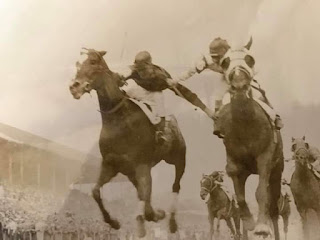
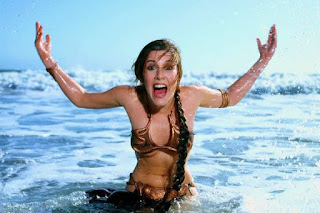
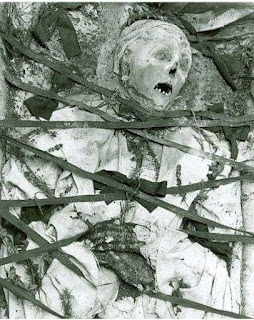
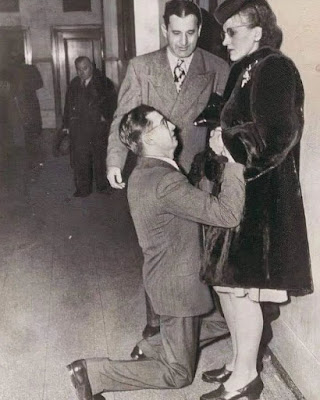
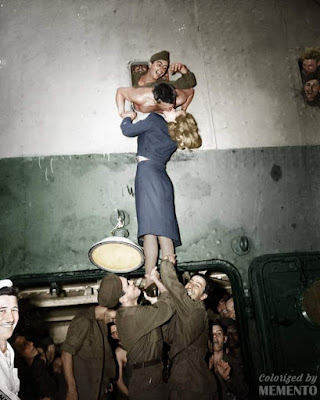


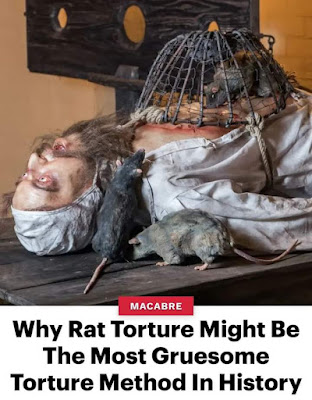

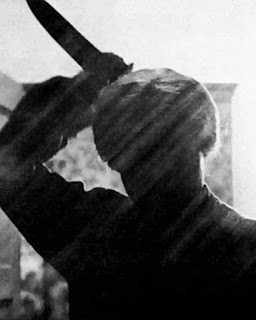

Comments
Post a Comment